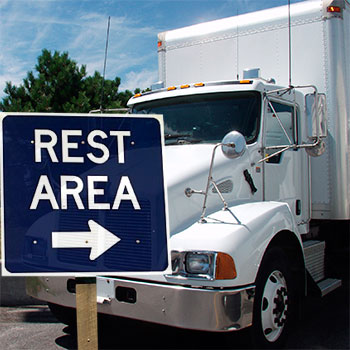New federal regulations mandating rest time for truckers could mean increased costs for consumers, according to a new study from UT’s Global Supply Chain Institute.
The new hours-of-service rules from the US Department of Transportation’s Federal Motor Carrier Safety Administration are designed to improve driver safety by reducing truck driver fatigue.
In place since July 1, the rules reduce the maximum number of truckers’ weekly driving hours from eighty-two to seventy and mandate a thirty-minute rest break prior to the eighth hour on duty.
But the rules also mean it might take longer for companies to transport their products or force them to add more truckers on the road.
The UT study surveyed 417 companies and found that 58 percent of them expected an increase in their carrier rates. They anticipated passing on the costs to their customers in the long term.
Mary Holcomb, an associate professor and the study’s author, believes that this is not a realistic solution. She is the Niedert Supply Chain Fellow in the UT Department of Marketing and Supply Chain Management, which is based in the College of Business Administration. Dean Vavalides, logistics analyst for Pilot Flying J, collaborated on the study.
“In this economy, companies won’t want to damage the relationships with their customers by raising prices,” Holcomb said. “Carriers may be unable to absorb these increased costs, so companies will have to improve their operations in order to minimize their impact.”
Holcomb’s study identifies ways companies could mitigate those costs. She noted that many of those businesses are incorporating some new initiatives.
“Many of them also will be a doubling down on efforts already underway,” she said.
Efforts to transport products more efficiently and control costs include the following:
- Extending lead time for some customers
- Increasing customer delivery windows
- Improving shipment consolidation
- Increasing the use of “drop and hook,” which involves dropping a loaded trailer at a customer’s facility and hooking up and leaving with another loaded trailer
The research also uncovered actions that many companies have yet to consider. Less than 5 percent of the polled companies planned to reduce costs by consolidating shipments with other companies.
“The logistics of coordinating shipping across companies is often too complex to sustain,” Vavalides said. “It just requires too much synchronization.”
Holcomb added that she was also surprised to discover that so few companies plan on shifting their transportation methods from truck to rail although research showed that long-haul moves have been the most impacted by the hours-of-service rule change. Switching the long-haul moves from truck to rail could reduce the arrival time, she said.
The UT Global Supply Chain Institute will conduct a follow-up study in mid-2014 on the longer-term impact of the hours-of-service rules.
Article topics
Email Sign Up



















